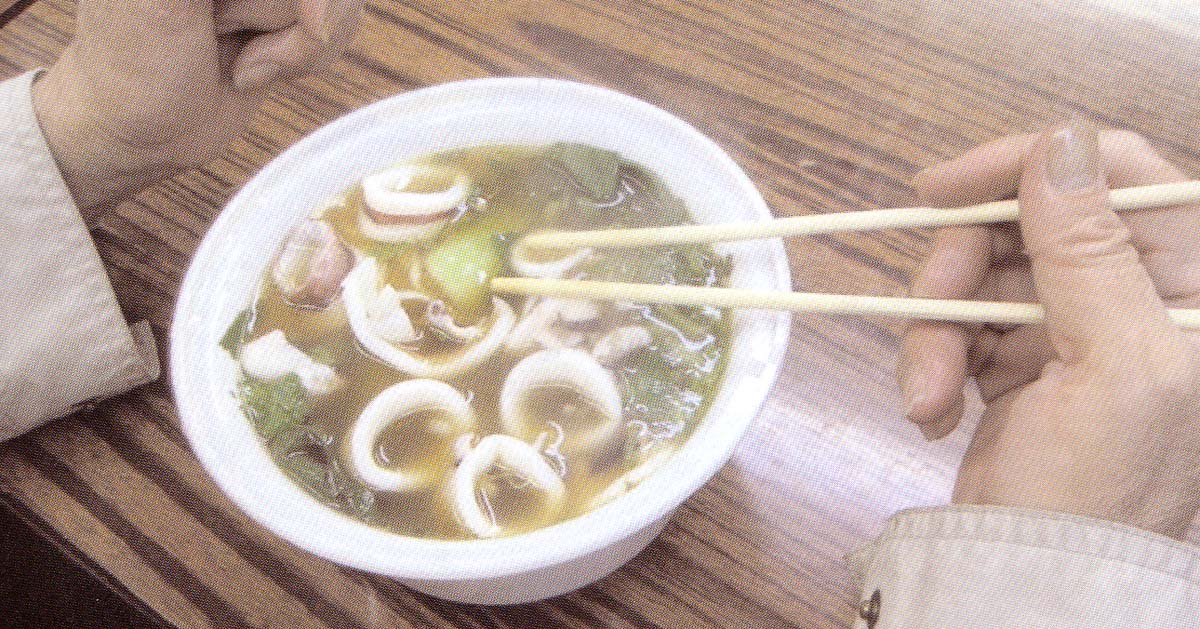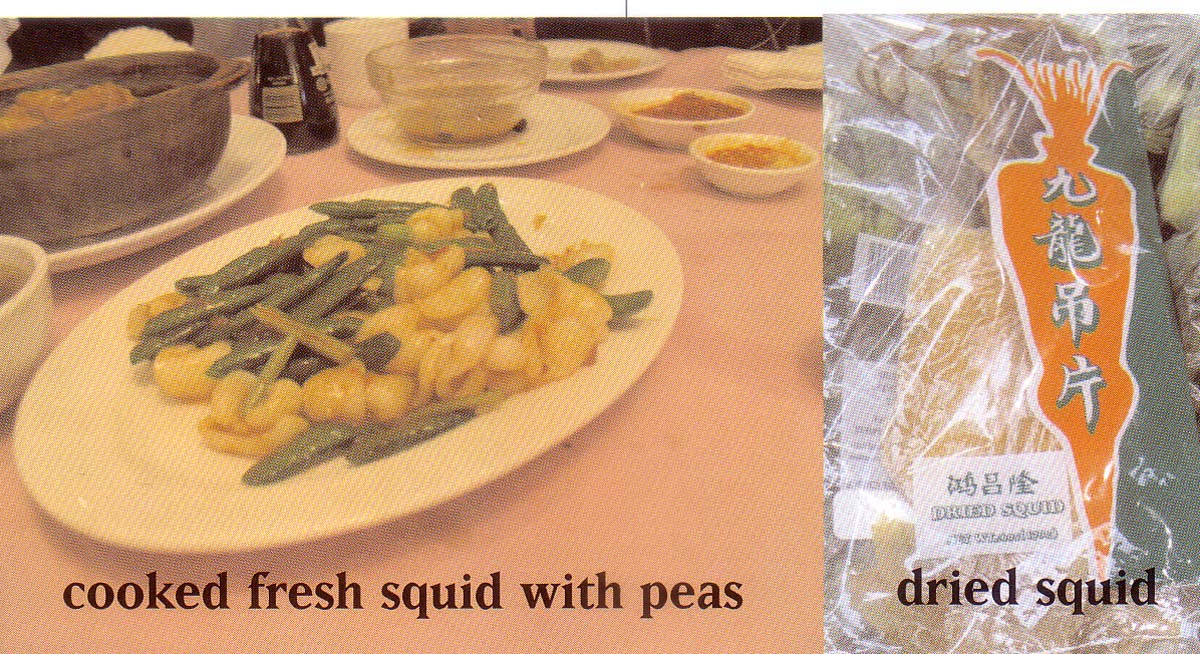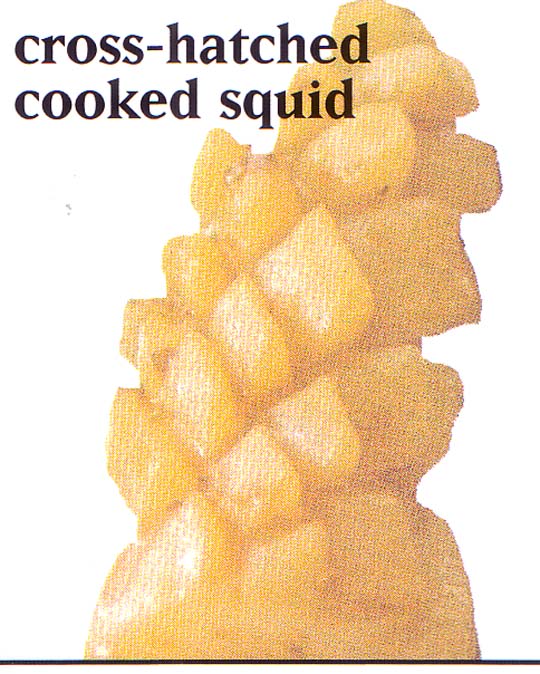
| What is Flavor and Fortune? |
| How do I subscribe? |
| How do I get past issues? |
| How do I advertise? |
| How do I contact the editor? |
Read 13358257 times
Connect me to:
| Home |
| Articles |
| Book reviews |
| Letters to the Editor |
| Newmans News and Notes |
| Recipes |
| Restaurant reviews |
| Article Index (all years, slow) |
| List of Article Years |
| Article Index (2026) |
| Article Index (last 2 years) |
| Things others say |
| Related Links |
| Log In... |
| Authors |
| Categories & Topics |
Squid, More About It
| by Jacqueline M. Newman |
Fish and Seafood
Summer Volume: 2009 Issue: 16(2) page(s): 32, 33, and 34
 Boneless, tubular, white-fleshed, with one head and two eyes, this most popular Cephalopod is used fresh, dried, and from frozen, in the Chinese culinary. Said to be without a bone, its central quill which some refer to as its backbone, does have another bony structure, often called its beak. It is found in the center of eight short tentacles and two long ones whose job is to reach out and catch prey. The tentacles are at the front of a squid, two fins are found at its rear.
Boneless, tubular, white-fleshed, with one head and two eyes, this most popular Cephalopod is used fresh, dried, and from frozen, in the Chinese culinary. Said to be without a bone, its central quill which some refer to as its backbone, does have another bony structure, often called its beak. It is found in the center of eight short tentacles and two long ones whose job is to reach out and catch prey. The tentacles are at the front of a squid, two fins are found at its rear.
There are more than two hundred species of squid worldwide, all called you yu by the Chinese, including the one known in English as the Flying Squid. Truth be told, this one does not fly but comes out of the water on its way from one place to another.
 Because squid lacks red blood, makes no tears, and is said to have no emotions, there are those, including the Chinese, who advise that squid has no food value and has no value as a food source. That is not true for at least two reasons. The first is they are a most abundant food source for Chinese, all Asians, and many other people. The second is that four ounces of raw squid have one hundred calories and only a mite more than a single gram of fat. They also have about eighty grams of protein, two grams of carbohydrate, fifteen milligrams of calcium, and one hundred twenty-five milligrams of phosphorus.
Because squid lacks red blood, makes no tears, and is said to have no emotions, there are those, including the Chinese, who advise that squid has no food value and has no value as a food source. That is not true for at least two reasons. The first is they are a most abundant food source for Chinese, all Asians, and many other people. The second is that four ounces of raw squid have one hundred calories and only a mite more than a single gram of fat. They also have about eighty grams of protein, two grams of carbohydrate, fifteen milligrams of calcium, and one hundred twenty-five milligrams of phosphorus.
 Squid is not a new food to the Chinese, nor is it one they do not eat. Quite the contrary, they have been part of the Chinese culinary, probably forever. During the Tang Dynasty (618 - 907 CE), they were a most important delicacy. Before that and since, there are writings about them fresh, salted, dried, and fried; the latter with ginger and vinegar. Writings these days also include them frozen, as many are cleaned and readied for market aboard ships long before they reach shore.
Squid is not a new food to the Chinese, nor is it one they do not eat. Quite the contrary, they have been part of the Chinese culinary, probably forever. During the Tang Dynasty (618 - 907 CE), they were a most important delicacy. Before that and since, there are writings about them fresh, salted, dried, and fried; the latter with ginger and vinegar. Writings these days also include them frozen, as many are cleaned and readied for market aboard ships long before they reach shore.
In places such as Fujian and other places with easy access to the sea, squid is most popular in soups and in stir-fried dishes. The Fujianese love them hot and sour and with chicken and vegetables. They also love them in dozens of their soups and stews.
Icthiologically known as Loligo edulio, there are two main kinds of squid. Those most popular are found near shore lines, while Ommastrephidae varieties are often larger and found in deeper waters. The best tasting and textured squid are those two to ten inches in length, smaller ones considered better. Many Chinese will tell you that shallow water soft fish, as they call them both in Chinese and in English, are really best.
TO CLEAN SQUID: Rub off the mottled exterior skin under running water. Then pull out the quill carefully and discard it. Next, pull off the head and eyes, the ink sac, and all innards, being careful not to break the ink sac. Discard these, then pull off the tentacles and remove the beak from the center of them, discarding the beak. Next rinse each squid and the tentacles carefully removing any sand.
If not stuffing them or cutting them crosswise making rings, slit the body lengthwise and rinse again. Next cross-hatch the flesh partway through in many places on their inner side. This is best done no more than one-quarter inch apart, even closer. Do this in two directions making tiny diamond shapes, and then cut them into one-inch or two-inch pieces. Now they are ready to pre-cook.
TO PRE-COOK squid is to ready them for final cooking in dishes. Drop all the pieces into boiling water or exceptionally hot oil, but for just a few seconds and certainly for less than half a minute, the cross-hatching makes them curl up, and the heat makes them turn very white. Before immersing them in hot water or oil, they may have been yellowish or tan, even with some spotty places; after this pre-cooking process, squid can be stir-fried, battered and deep-fried, or simply added to soups or stews.
Have you wondered why dried squid is flat and brown? It is because commercially, they are rolled and flattened, then dried. Some are even toasted over charcoal. If using dried squid, be sure to soak them changing the water several times. Soak them for twenty-four to forty-eight hours. The time depends upon size and length of time the squid was in this dried state. They are ready to cut and pre-cook when their soft bony structures are removed, and they are rinsed well.
Dried squid, considered a delicacy, has a subtle aroma, and often a strong taste. They are chewy, and sometimes served along with fresh squid. The Chinese like these contrasting textures. Cook reconstituted dried ones with lots of ginger, this helps mask their strong taste. They need the same cross-hatching as do fresh ones, and do cut them into half-inch pieces before cooking.
Dried squid can keep virtually forever. However, they must be wrapped tightly and stored in a cool dark place. We recommend wrapping each dried squid in fresh brown paper, such as a cut-open lunch bag, then put plastic around that, being sure that there is no aperture for air to get in. Re-wrap them every two months or so. Be sure there is no writing on the brown paper because if there is, the squid will acquire that color.
| Stuffed Fresh Squid |
|---|
2 fresh squid, cleaned as indicated above, then blanched in boiling water for half minute 1 fresh chili pepper, seeds discarded, and minced 1/4 cup minced peeled large white radish 2 small Kirby-like cucumbers, minced 1/4 cup minced peeled fresh ginger 2 Tablespoons Chinese white vinegar 1 Tablespoon granulated sugar 1 Tablespoon sesame oil 1 small carrot, peeled and minced 1 or 2 leaves lettuce Preparation: 1. Remove tentacles, and mince them, then mix them with the minced chili pepper, white radish, cucumbers, and ginger, and stir in the vinegar, sugar, sesame oil, minced carrot. Let rest covered in the refrigerator for one hour. 2. Remove from the refrigerator and ring out any liquid, then stuff the ingredients tightly into the squid, and refrigerate covered for another hour. 3. Put lettuce on a plate, then using an exceptionally sharp knife, cut the squid into one-inch rings and put them cut side up on a plate. Then serve. |
| Stir-fried Squid, Cantonese-style |
|---|
1 pound fresh squid, cleaned, then blanched in boiling water for half minute, removed and drained, then cut in half and then into very thin strips 1/4 cup cornstarch 1/4 teaspoon Sichuan pepper or black pepper 1/4 teaspoon coarse salt 3 Tablespoons vegetable oil 3 sprigs fresh coriander, stems and leaves minced 1 scallion, minced 1 slice fresh ginger, minced Preparation: 1. Mix squid strips, cornstarch, pepper and salt, and shake to remove any excess starch, and set it aside. 2. In a wok or a large fry-pan, heat oil, and blanch half the squid for half minute, remove and drain; then repeat with the rest of the squid, leaving any remaining oil in the wok. 3. Mix coriander, scallion, and ginger. 4. Reheat wok with its remaining oil, and stir-fry the coriander mixture for one minute. Mix all the squid with one tablespoon of the cornstarch mixture, then add all the fried squid, and stir-fry for half minute, then plate and serve. |
| Squid with Black Bean Sauce |
|---|
2 teaspoons fermented black beans, rinsed and mashed 2 teaspoons Chinese rice wine 2 teaspoons sesame oil 1 Tablespoon thin soy sauce 1 Tablespoon brown sugar 1/2 teaspoon granulated sugar 1 Tablespoon vegetable oil 6 cloves garlic, peeled and thinly sliced 2 Tablespoon fresh ginger, minced 1 to 2 red chili peppers, seeded and minced 1 pound fresh squid, cleaned, blanched, cross-hatched, and cut into one-inch pieces 2 sprigs fresh coriander, cut into half-inch pieces Preparation: 1. Mix mashed black beans, rice wine, sesame oil, soy sauce, brown and granulated sugars, and one tablespoon of cold water and set aside. 2. Heat wok or large fry pan, add the oil, and stir-fry the garlic, ginger, and chili peppers for one minute. 3. Add the black bean mixture and stir-fry another minute before adding the squid. Stir-fry one additional minute, no more, then remove to a serving bowl. Sprinkle the coriander on top, and serve. |
| Squid Pancake |
|---|
1 small dried squid, soaked overnight or until soft 1/2 pound ground or minced pork 1 Tablespoon cornstarch 2 slices fresh ginger, minced 1 teaspoon granulated sugar 1 Tablespoon Chinese rice wine 1.2 teaspoon slat and ground white pepper Preparation: 1. Mince squid, then mix it with all the other ingredients, stirring gently when doing so. Then put this in a small flat heat-proof dish with sides making a pancake. 2. Steam over rapidly boiling water for half an hour. 3. Remove any liquid from the bowl. It can be discarded or thickened with one tablespoon of cornstarch mixed with two tablespoons of cold water and brought to the boil. 4. Serve on a clean plate, cutting the pancake into four pieces with or without pouring the thickened sauce over the squid pancake. |
| Hot and Sour Five-flavor Squid Soup |
|---|
2 fresh squid, cleaned, cut in half, then blanched in boiling water for half minute, and cut into thin strips 1 soaked dried squid, cut in half, cut into half-inch thin strips, each of which is cut as if cutting in half, but not cutting all the way through 2 Tablespoons minced fresh coriander, stems removed and tied into knots 1 scallion, minced 2 slices fresh ginger, minced 2 cloves fresh garlic, peeled and minced 1 Tablespoon chili oil 1 Tablespoon thick soy 1 Tablespoon granulated sugar 1/4 teaspoon ground white pepper 1 small tomato, peeled and seeded, them minced 1 teaspoon sesame oil 8 cups boiling chicken broth 1 or 2 fresh scallops, coarsely chopped Preparation: 1. Mix all ingredients together, and then return to the boil. 2. Pour into a large soup tureen, return to the boil, then serve. |
| Steamed Squid with Silk Squash |
|---|
1/2 pound fresh squid, cleaned, cut in half, cross-hatched, cut into half-inch pieces, and oil or water blanched for half minute 1 teaspoon cornstarch 1/2 teaspoon ground white pepper 1 silk squash, peeled, cut in half the long way, then sliced 4 cloves garlic, peeled and chopped coarsely 1 Tablespoon thin soy sauce 1 Tablespoon sesame oil 1 Tablespoon fried shallots Preparation: 1. Mix squid with cornstarch and ground white pepper. 2. Put silk squash on a heat proof wide bowl, and top with the squid. Sprinkle garlic, soy sauce, and sesame oil over them, and steam over rapidly boiling water for five or six minutes, Sprinkle the fried shallots of top, and serve |
| Gung Bao Squid |
|---|
1 cup vegetable oil 2 soaked dried squid, washed, cut in half, and cross-hatched 1/4 cup dried chili peppers, partially cut in half, seeds removed, but left attached 2 cloves garlic, peeled and minced 2 slices fresh ginger, minced 2 teaspoons granulated sugar 1 Tablespoon Chinese black vinegar 1 teaspoon cornstarch mixed with one teaspoon cold water 1 teaspoon sesame oil 1 Tablespoon Chinese rice wine Preparation: 1. Heat oil, and oil-blanch the squid for one minute, remove the squid and drain well, setting the oil aside. 2. Put two tablespoons of the reserved oil into a wok or fry pan, and stir-fry the chili peppers, garlic, and ginger for one minute, then add squid, sugar, vinegar, cornstarch mixture, sesame oil, and the rice wine. Bring to the boil, transfer to a bowl, and serve. |

Copyright © 1994-2026 by ISACC, all rights reserved
Address
3 Jefferson Ferry Drive
S. Setauket NY 11720